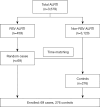Risk factors for respiratory syncytial virus (RSV) infection in children under 5 years old with acute lower respiratory tract infection
- PMID: 40809250
- PMCID: PMC12340257
- DOI: 10.21037/jtd-2024-2170
Risk factors for respiratory syncytial virus (RSV) infection in children under 5 years old with acute lower respiratory tract infection
Abstract
Background: Respiratory syncytial virus (RSV) infection is a significant burden for children under 5 years of age. While RSV is a common cause of acute lower respiratory tract infection (ALRTI), routine confirmatory testing is not widely practiced. Identifying risk factors for RSV infection can help inform clinical decision-making and guide appropriate management in emergency departments. The objective of this study is to determine the risk factors associated with RSV infection in children hospitalized with ALRTI.
Methods: A retrospective case-control study was conducted among pediatric patients under 5 years of age diagnosed with ALRTI at Naresuan University Hospital between January 2018 and December 2020. Data were extracted from electronic medical records. RSV diagnoses were confirmed using a rapid RSV antigen test. Potential risk factors-including prematurity, family history of atopic disease, past respiratory illness, history of ALRTI contact, and underlying disease-were analyzed using a multivariable logistic model in Stata version 17.0.
Results: Among 3,579 children hospitalized with ALRTI, 459 (13%) were diagnosed with RSV infection. Peaks in RSV-ALRTI were observed in September, October, and November across 2018-2020. Significant risk factors identified through multivariable logistic regression analysis included the rainy season [odds ratio (OR) =15.51; 95% confidence interval (CI): 1.74-138.42; P=0.01], daycare attendance (OR =3.00; 95% CI: 1.27-7.10; P=0.01), lung crepitations (OR =2.60; 95% CI: 1.23-5.50; P=0.01), and oxygen supplementation (OR =2.38; 95% CI: 1.07-5.30; P=0.03).
Conclusions: This study highlights the significant clinical burden of RSV in ALRTI, with RSV-ALRTI accounting for 13% of all ALRTI cases. Notably, RSV-ALRTI cases peaked during the rainy season, specifically in September, October, and November. The identified risk factors for RSV-ALRTI include the rainy season, daycare attendance, lung crepitations, and the need for oxygen supplementation. These findings underscore the importance of early identification and management of high-risk patients, particularly during peak seasonal periods. Clinically, these risk factors can help guide targeted prevention and treatment strategies, improving patient outcomes and optimizing resource allocation in healthcare settings.
Keywords: Lower respiratory tract infection; respiratory syncytial virus (RSV); risk factors.
Copyright © 2025 AME Publishing Company. All rights reserved.
Conflict of interest statement
Conflicts of Interest: All authors have completed the ICMJE uniform disclosure form (available at https://jtd.amegroups.com/article/view/10.21037/jtd-2024-2170/coif). The authors have no conflicts of interest to declare.
Figures
Similar articles
-
Risk factors for severe lower respiratory tract infection among children under 5 years of age hospitalized with respiratory syncytial virus.Eur J Clin Microbiol Infect Dis. 2025 Jun 25. doi: 10.1007/s10096-025-05191-9. Online ahead of print. Eur J Clin Microbiol Infect Dis. 2025. PMID: 40560508
-
Palivizumab for immunoprophylaxis of respiratory syncytial virus (RSV) bronchiolitis in high-risk infants and young children: a systematic review and additional economic modelling of subgroup analyses.Health Technol Assess. 2011 Jan;15(5):iii-iv, 1-124. doi: 10.3310/hta15050. Health Technol Assess. 2011. PMID: 21281564 Free PMC article.
-
Prescription of Controlled Substances: Benefits and Risks.2025 Jul 6. In: StatPearls [Internet]. Treasure Island (FL): StatPearls Publishing; 2025 Jan–. 2025 Jul 6. In: StatPearls [Internet]. Treasure Island (FL): StatPearls Publishing; 2025 Jan–. PMID: 30726003 Free Books & Documents.
-
A systematic review of compliance with palivizumab administration for RSV immunoprophylaxis.J Manag Care Pharm. 2010 Jan-Feb;16(1):46-58. doi: 10.18553/jmcp.2010.16.1.46. J Manag Care Pharm. 2010. PMID: 20131495 Free PMC article.
-
Palivizumab for preventing severe respiratory syncytial virus (RSV) infection in children.Cochrane Database Syst Rev. 2021 Nov 16;11(11):CD013757. doi: 10.1002/14651858.CD013757.pub2. Cochrane Database Syst Rev. 2021. Update in: Cochrane Database Syst Rev. 2025 Jul 23;7:CD013757. doi: 10.1002/14651858.CD013757.pub3. PMID: 34783356 Free PMC article. Updated.
References
LinkOut - more resources
Full Text Sources
Miscellaneous


